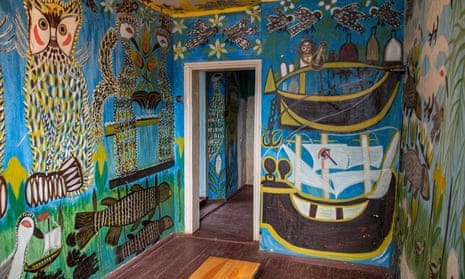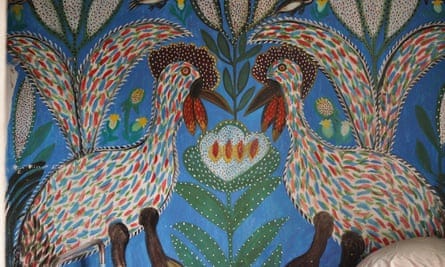Jun 12: Emma Graham-Harrison, ‘Masterpiece’ house is latest victim of Putin’s war on Ukrainian heritage
As published in The Guardian on June 12, 2023
‘Masterpiece’ house is latest victim of Putin’s war on Ukrainian heritage
By Emma Graham-Harrison, The Guardian, 12 June 2023
Artists from across Ukraine made pilgrimages to Polina Rayko’s home, which many fear has been destroyed after Kakhovka dam collapse.

Polina Rayko only took up a paintbrush aged 69 and her only canvas was the walls of her modest village home. But in just six years, she created a national treasure, and became an icon of folk art in southern Ukraine.
That house, decorated with images inspired by the rich natural life of the floodplains that backed on to Rayko’s garden, is the latest casualty of the Kharkovka dam collapse.
Rayko spent her life in Oleshky village, in southern Kherson, among those worst affected by the flood unleashed last week. It is under Russian occupation, so no one has been able to go and assess the state of the house she turned into a masterpiece, but even the limited news that has filtered out is devastating.
“The last thing we know is that the neighbours said the first floor of their house was flooded, which means that Rayko’s will be submerged up to the roof,” said Simon Khramtsov, an artist and designer from Kherson, who works with the foundation that preserved Rayko’s work. “If something survives, it will be fragmentary.”
The waters could go down, or if more of the dam collapses, rise further, the house could even be washed away entirely. But its traditional structure means even a few days underwater is likely to have caused extensive, irreparable damage.
“Most likely, we will lose it, because the house was made of a samanna [an unburned mixture of clay, straw, and sand] covered with silicate bricks,” said Oksana Semenik, an art historian and journalist who runs the Ukrainian Art History account on Twitter.
“Her main and the only artwork was this house. We have lost her heritage and her physical presence.”

Rayko was part of an important tradition of naive or folk art in Ukraine that inspired more formally taught contemporaries.
Perhaps the most famous of Polina’s predecessors in this tradition, painter Maria Prymachenko, has also been a target in this war. An attack on her native Ivankiv set a museum housing many of her works on fire, some were lost, and locals risked their lives to save 25.
The invasion launched by the Russian president, Vladimir Putin, does not simply aim to annex Ukrainian territory; it means to erase Ukrainian culture, history and heritage. Monuments and art treasures have been frequent targets.
The destruction of Rayko’s masterpiece comes on top of another, human loss. Ukrainian artist Viacheslav Mashnytskyi, one of the first to discover Rayko, and her great champion in the region has been missing since last year.
When Russian troops were driven out of the region last autumn, friends found bloodstains at his house, his furniture overturned, but no trace of the artist himself. “His fate is still unknown. He was an important figure in Ukrainian art and especially for Kherson,” Semenik said.

Rayko started painting as a way to process her grief after enduring a wave of tragedies, including the loss of her husband and the death of her only daughter in a car crash. Her son became an addict, was abusive to her and was eventually arrested.




